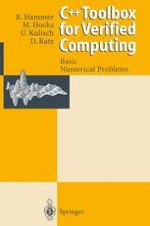Our aim in writing this book was to provide an extensive set of C++ programs for solving basic numerical problems with verification of the results. This C++ Toolbox for Verified Computing I is the C++ edition of the Numerical Toolbox for Verified Computing l. The programs of the original edition were written in PASCAL-XSC, a PASCAL eXtension for Scientific Computation. Since we published the first edition we have received many requests from readers and users of our tools for a version in C++. We take the view that C++ is growing in importance in the field of numeri cal computing. C++ includes C, but as a typed language and due to its modern concepts, it is superior to C. To obtain the degree of efficiency that PASCAL-XSC provides, we used the C-XSC library. C-XSC is a C++ class library for eXtended Scientific Computing. C++ and the C-XSC library are an adequate alternative to special XSC-Ianguages such as PASCAL-XSC or ACRITH-XSC. A shareware version of the C-XSC library and the sources of the toolbox programs are freely available via anonymous ftp or can be ordered against reimbursement of expenses. The programs of this book do not require a great deal of insight into the features of C++. Particularly, object oriented programming techniques are not required.
